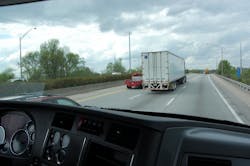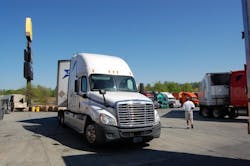Let’s face it: a trucking company can have the newest, shiniest trucks and trailers hitched to the latest-and-greatest computer system for managing loads, but without solid men and women behind the wheel, all of that comes to naught.
One of the struggles facing trucking right now as it deals with an ever-expanding shortage of drivers revolves around what one could call the “worth” of human capital. I’ve written about this subject before in this space but it’s worth revisiting again as the problem is only seeming to worsen in the near future.
For example, look what the Department of Labor says is the median yearly wage for tractor-trailer drivers: $37,770. That means half of the drivers in the industry are paid above that salary line, while half of them get paid below it.
Would you call that a “decent” salary? Sure – if you’re single with no children to support. Trying to raise a family on such a salary, however, while being away from home for long stretches of time simply doesn’t add up for many people – especially the ones who would be most likely to drive big rigs the safest, deliver freight on time, all while burnishing a fleet’s reputation with their manner at every stop.This issue isn’t trucking problem alone, either, as many businesses are staring a lot of strategic “human capital” problems in the face.
Take a new report by The Conference Board and McKinsey & Company for example dubbed the State of Human Capital 2012, which among other things notes that while tremendous strides have been made over the past decade in areas like workplace diversity and flexibility, the “human capital” function has largely lagged behind in effecting organizational success.
The two firms suggest that company executives make some serious adjustments if they are to effectively manage the global talent pool in what’s become an unpredictable global business environment:
- Look ahead: anticipate and plan for the human capital of tomorrow– From the increased presence of the highly connected millennial generation to the proliferation of the virtual office, tomorrow's workplace will look very different from those of today'.
- Secure a steady, reliable pipeline for today's skilled workers and tomorrow's leaders– The “war for talent” in their words continues, spurred by relatively high growth in emerging markets and the mismatch between worker skills and jobs in most regions of the world.
- Develop strategies to reenergize your employees about what they do, and about what the organization stands for– An engaged workforce can drive financial performance. Studies have shown that employees who are truly engaged are more likely to stay and contribute to the organization.
- Ensure more agility within your organization as a whole– Organizational agility is an essential response to the volatility of today's business environment a Massachusetts Institute of Technology (MIT) MIT study shows that agile organizations grow revenue 37% faster and generate 30% higher profits than non-agile organizations.
"In today's global marketplace, particularly in such a hostile and unpredictable business environment, human capital departments are struggling to deal with a global talent shortage, adapt to a changing workforce, and develop new, flexible working models to meet the needs of tomorrow's workers,” noted Bryan Hancock, a partner in McKinsey & Co.’s Atlanta office.
He believes many “human capital” efforts are often “paralyzed” today in the face of seemingly monumental challenges such as accelerating leadership development, acquiring talent, and retaining key players in a world of constant change across borders and cultures.
Those issues resonate in trucking as well and will only continue to do so down the road.


